Distribution Characteristics and Source Analysis of Nitrogen and Phosphorus in Different Rivers in Two Water Period: A Case Study of Pi River and Shiting River in the Upper Reaches of Tuo River in China
Abstract
:1. Introduction
2. Materials and Methods
2.1. Description of the Study Area
2.2. Determination and Quality Control of Nitrogen and Phosphorus Fractions
3. Results and Discussion
3.1. Distribution Characteristics of Total Phosphorus Concentration and Pollution Levels in Water
3.2. Distribution Characteristics of Total Nitrogen Concentration and Pollution Levels in Water
3.3. Distribution Characteristics of Nitrogen and Phosphorus Fraction Concentrations and Pollution Levels in Water
3.4. Distribution Characteristics of Total Phosphorus Content and Pollution Levels in Surface Sediments
3.5. Distribution Characteristics of Total Nitrogen Content and Pollution Levels in Surface Sediments
3.6. Distribution Characteristics of Nitrogen and Phosphorus Fraction Contents and Pollution Levels in Surface Sediments
3.7. Ratio of Nitrogen to Phosphorus in the Water of the Pi and Shiting Rivers
4. Source Analysis of Nitrogen and Phosphorus in the Pi and Shiting Rivers
4.1. Correlation Analysis
4.2. Cluster Analysis
4.3. Principal Component Analysis
5. Conclusions
Supplementary Materials
Author Contributions
Funding
Institutional Review Board Statement
Informed Consent Statement
Data Availability Statement
Conflicts of Interest
References
- Smith, V.H.; Schindler, D.W. Eutrophication science: Where do we go from here? Trends Ecol. Evol. 2009, 24, 201–207. [Google Scholar] [CrossRef] [PubMed]
- Du, M.; Liu, Q.; Luo, B.; Zhang, D. Evaluation and analysis of present water environment quality of MinJiang & TuoJiang river basins. Sichuan Environ. 2016, 35, 20–25. [Google Scholar]
- Qin, Y.W.; Ma, Y.Q. Characteristics and effecting factors of phosphorus pollution in upstream of TuoJiang River (Deyang section). Phosphate Compd. Fert. 2020, 35, 15–18. [Google Scholar]
- Xu, J.; Wang, Y.G.; Chen, Y.; Tong, H.J.; Wei, Y.; Bai, H. Characteristics on spatiotemporal variations of surface water environmental quality in TuoJiang river in upper reaches of yangtze river basin. Earth Sci. 2020, 45, 1937–1947. [Google Scholar]
- Zhang, Y.X.; Wei, Y.; Wang, T. Pollution assessment and spatiotemporal distribution of nitrogen and phosphorus concentrations of rivers in Tuojiang River Basin. Environ. Pollut. Prev. 2021, 43, 1028–1034. [Google Scholar]
- Feng, W.Y.; Yang, F.; Zhang, C.; Liu, J.; Song, F.H.; Chen, H.Y.; Zhu, Y.R.; Liu, S.S.; Giesy, J.P. Composition characterization and biotransformation of dissolved, particulate and algae organic phosphorus in eutrophic lakes. Environ. Pollut. 2020, 265, 114838. [Google Scholar] [CrossRef]
- Mbabazi, J.; Inoue, T.; Yokota, K.; Saga, M. Phosphorus bioavailability in rivers flowing through contrasting land uses. J. Environ. Chem. Eng. 2019, 7, 102960. [Google Scholar] [CrossRef]
- Shi, P.; Zhang, Y.; Song, J.X.; Li, P.; Wang, Y.S.; Zhang, X.M.; Li, Z.B.; Bi, Z.L.; Zhang, X.; Qin, Y.L. Response of nitrogen pollution in surface water to land use and social-economic factors in the Weihe River watershed, northwest China. Sustain. Cities Soc. 2019, 50, 101658. [Google Scholar] [CrossRef]
- Wu, Y.C.; Gan, M.L.; Huang, X.P.; Jiang, Z.J.; Liu, S.L. Fractions and mineralization potential of the sediment organic nitrogen in Daya Bay, South China Sea: Anthropogenic influence and ecological implications. Mar. Pollut. Bull. 2020, 160, 111594. [Google Scholar] [CrossRef]
- Mouri, G.; Takizawa, S.; Oki, T. Spatial and temporal variation in nutrient parameters in stream water in a rural-urban catchment, Shikoku, Japan: Effects of land cover and human impact. J. Environ. Manag. 2011, 92, 1837–1848. [Google Scholar] [CrossRef]
- Schoonover, J.E.; Lockaby, B.G. Land cover impacts on stream nutrients and fecal coliform in the lower Piedmont of West Georgia. J. Hydrol. 2006, 331, 371–382. [Google Scholar] [CrossRef]
- Chen, H.; Hao, F.H.; Ou Yang, W.; Wang, X.L.; Yang, S.T. Eco-Environmental water requirements for lower reaches of pihe river in chengdu plain. Res. Environ. Yangtze Basin 2017, 16, 644–649. [Google Scholar]
- Li, B.Q. Measurement and calculation of cost water price about first phase of water supply works in Pihe River. Sichuan Water Res. 2007, 28, 69–73. [Google Scholar]
- Deyang Local History Compilation Committee. Deyang Zhi (I & II); Sichuan People’s Publishing House: Chengdu, China, 2003. [Google Scholar]
- Gao, Q.Q.; Yang, X.; Wu, J.L.; Yang, Y.Q.; Fu, D.Y. Water quality trend analysis and control research of jinlun section in shiting river basin. Shaanxi Water Res. 2022, 7, 95–97. [Google Scholar]
- Peng, Q.G.; Wang, X.Y.; Shi, Z.M. Source apportionment and risk assessment of pollutants in farmland soil based on township scale. Earth Environ. 2021, 49, 694–706. [Google Scholar]
- GB 11893-89; Water Quality-Determination of Total Phosphorus-Ammonium Molybdate Spectrophotometric Method. Standards Press of China: Beijing, China, 1990.
- Fang, T. Phosphorus speciation and budget of the East China Sea. Cont. Shelf Res. 2004, 24, 1285–1299. [Google Scholar] [CrossRef]
- GB 11895-89; Water Quality-Determination of Total Nitrogen-Alkaline potassium Persulfate Digestion UV Spectrophotometric Method. Standards Press of China: Beijing, China, 1990.
- HJ 535-2009; Water Quality-Determination of Ammonia Nitroge—Nessler’s Reagent Spectrophotometry. China Environmental Science Press: Beijing, China, 2010.
- HJ/T 346-2007; Water Quality-Determination of Nitrate-Nitrogen-Ultraviolet Spectrophotometry. China Environmental Science Press: Beijing, China, 2007.
- GB 7493-87; Water Quality-Determination of Nitrogen (Nitrite)-Spectrophotometric Method. Standards Press of China: Beijing, China, 1987.
- Ruban, V.; Brigault, S.; Demare, D.; Philippe, A.M. An investigation of the origin and mobility of phosphorus in freshwater sediments from Bort-Les-Orgues Reservoir, France. J. Environ. Monit. 1999, 1, 403–407. [Google Scholar] [CrossRef]
- Hupfer, M.; Gächter, R.; Giovanoli, R. Transformation of phosphorus species in settling seston and during early sediment diagenesis. Aquat. Sci. 1995, 57, 305–324. [Google Scholar] [CrossRef]
- Psenner, R.; Pucsko, R.; Sage, M. Fractionation of organic and inorganic phosphorus compounds in lake sediments, an attempt to characterize ecologically important fractions. Arch. Hydrobiol. 1984, 70, 111–155. [Google Scholar]
- Qian, J.L.; Zhang, L.D.; Le, M.L. Determination of total nitrogen and phosphorus in soil by persulfate digestion. Soils 1990, 22, 258–262. [Google Scholar]
- Jiang, X.; Wang, S.H. Sediment Quality Investigation and Assessment Manual; China Science Publishing & Media Ltd.: Beijing, China, 2012. [Google Scholar]
- Tang, M.K.; Zheng, C.J.; Liao, Q.G.; Yang, B.; Li, B.; Pang, L.; Li, C.J. Assessment of river health on the basis of riparian plant diversity: Taking the Baitiao-fu river as an example. J. Sichuan Sci. Technol. 2014, 35, 9–16. [Google Scholar]
- GB 3838-2002; Environmental Quality Standards for Surface Water. China Environmental Science Press: Beijing, China, 2002.
- Jin, X.C.; Tu, Q.Y. Lake Eutrophication Survey Specification, 2nd ed.; China Environmental Science Press: Beijing, China, 1990. [Google Scholar]
- Zhang, H.; Xin, M.; Wang, B.D.; Wang, J.; Lin, C.Y.; Gu, X.; Ouyang, W.; Liu, X.T.; He, M.C. Spatiotemporal variations in phosphorus concentrations in the water and sediment of Jiaozhou Bay and sediment phosphorus release potential. Sci. Total Environ. 2022, 806, 150540. [Google Scholar] [CrossRef] [PubMed]
- Feng, L.J.; Yao, J. Study on water quality evaluation and control countermeasures of Deyang section of Yazi river. J. Green Sci. Technol. 2018, 6, 25–27. [Google Scholar]
- Schneider, S.C.; Cara, M.; Eriksen, T.E.; Goreska, B.B.; Imeri, A.; Kupe, L.; Lokoska, T.; Patceva, S.; Trajanovska, S.; Trajanovski, S. Eutrophication impacts littoral biota in Lake Ohrid while water phosphorus concentrations are low. Limnologica 2014, 44, 90–97. [Google Scholar] [CrossRef]
- Wang, Z.Z.; Zhang, Y.M.; Guo, Y.C.; Li, Z.W. Effect of organophosphorus pesticide pollution on soil animals. J. Environ. Sci. 2000, 12, 47–56. [Google Scholar]
- Yi, Q.T.; Zhang, Y.; Xie, K.; Chen, Q.W.; Zheng, F.F.; Tonina, D.; Shi, W.Q.; Chen, C. Tracking nitrogen pollution sources in plain watersheds by combining high-frequency water quality monitoring with tracing dual nitrate isotopes. J. Hydrol. 2020, 581, 124439. [Google Scholar] [CrossRef]
- Zhao, M.M.; Chen, Y.P.; Xue, L.G.; Fan, T.T.; Emaneghemi, B. Greater health risk in wet season than in dry season in the Yellow River of the Lanzhou region. Sci. Total Environ. 2018, 644, 873–883. [Google Scholar] [CrossRef]
- Promote the Sustainable Improvement of Ecological Environment in Shiting River Basin. Available online: http://www.deyang.gov.cn/xwdt/bmdt/924893.htm?fkfkfkfcjekfkfcj (accessed on 30 August 2022).
- Wang, L.Q.; Liang, T. Distribution patterns and dynamics of phosphorus forms in the overlying water and sediment of Dongting Lake. J. Great Lakes Res. 2016, 42, 565–570. [Google Scholar] [CrossRef]
- Lin, P.; Klump, J.V.; Guo, L.D. Dynamics of dissolved and particulate phosphorus influenced by seasonal hypoxia in Green Bay, Lake Michigan. Sci. Total Environ. 2016, 541, 1070–1082. [Google Scholar] [CrossRef]
- Mbabazi, J.; Inoue, T.; Yokota, K.; Saga, M. Variability of particulate bioavailable phosphorus, particulate organic carbon and nitrogen in agricultural and urban rivers. J. Environ. Chem. Eng. 2019, 7, 103086. [Google Scholar] [CrossRef]
- Yin, X.J.; Chen, L.J.; Tang, D.Q.; Zhang, Y.; Liu, G.L.; Hua, Y.M.; Wan, X.Q.; Zhou, W.B.; Zhao, J.W.; Zhu, D.W. Seasonal and vertical variations in the characteristics of the nitrogen-related functional genes in sediments from urban eutrophic lakes. Appl. Soil Ecol. 2019, 143, 80–88. [Google Scholar] [CrossRef]
- Schlesinger, W.; Bernhardt, E. Biogeochemistry: An Analysis of Global Change, 4th ed.; Academic Press: Cambridge, UK, 2020; pp. 483–508. [Google Scholar]
- Dalu, T.; Cuthbert, R.N.; Taylor, J.C.; Magoro, M.L.; Weyl, O.L.F.; Froneman, P.W.; Wasserman, R.J. Benthic diatom-based indices and isotopic biomonitoring of nitrogen pollution in a warm temperate Austral river system. Sci. Total Environ. 2020, 748, 142452. [Google Scholar] [CrossRef] [PubMed]
- Xu, D.; Yan, P.; Liu, Z.S.; Zhang, M.Z.; Yan, W.H.; Liu, Y.L.; Wu, Z.B.; Zhang, Y. Spatial distribution of phosphorus forms and the release risk of sediments phosphorus in West Lake, Hangzhou, China. Ecol. Eng. 2021, 173, 106421. [Google Scholar] [CrossRef]
- United States Environmental Protcction Agency (USEPA). Guidelines for the Pollutional Classification of Great Lakes Harbor Sediments; Environmental Protection Agency: Chicago, IL, USA, 1977. [Google Scholar]
- Mudroch, A.; Azcue, J. Manual of Aquatic Sediment Sampling; Lewis Publishers: Boca Raton, FL, USA, 1995. [Google Scholar]
- Li, Y.N.; Wang, M.R.; Chen, X.J.; Cui, S.L.; Hofstra, N.; Kroeze, C.; Ma, L.; Xu, W.; Zhang, Q.; Zhang, F.S. Multi-pollutant assessment of river pollution from livestock production worldwide. Water Res. 2022, 209, 117906. [Google Scholar] [CrossRef]
- Zhou, Y.; Xiao, C.Q.; Yang, S.; Yin, H.Q.; Yang, Z.Y.; Chi, R. Life cycle assessment and life cycle cost analysis of compound microbial fertilizer production in China. Sustain. Prod. Consum. 2021, 28, 1622–1634. [Google Scholar] [CrossRef]
- Chen, S.Y.; Chen, Y.Y.; Liu, J.Z.; Zhang, J.; Wu, A.Q. Vertical variation of phosphorus forms in core sediments from Dongping Lake, China. Procedia Environ. Sci. 2011, 10, 1797–1801. [Google Scholar]
- Song, Z.X.; Shan, B.Q.; Tang, W.Z.; Zhang, H.; Wang, C.; Zhao, Y. Phosphorus distribution and sorption-release characteristics of the soil from newly submerged areas in the Danjiangkou reservoir, China. Ecol. Eng. 2017, 99, 374–380. [Google Scholar] [CrossRef]
- Hou, D.K.; He, J.; Lü, C.W.; Dong, S.W.; Wang, J.H.; Xie, Z.L.; Zhang, F.J. Spatial variations and distributions of phosphorus and nitrogen in bottom sediments from a typical north-temperate lake, China. Environ. Earth Sci. 2014, 71, 3063–3079. [Google Scholar] [CrossRef]
- Liu, Y.J.; Huang, S.Z.; Zhang, L.; Peng, X.; Zhang, X.Y.; Ge, F.J.; Liu, B.Y.; Wu, Z.B. Spatial distribution characteristics of phosphorus fractions and release risk in sediments of Honghu international importance wetland. Environ. Sci. 2021, 42, 3198–3205. [Google Scholar]
- Zhou, A.M.; Wang, D.S.; Tang, H.X. Phosphorus fractionation and bio-availability in Taihu Lake (China) sediments. J. Environ. Sci. 2005, 17, 384–388. [Google Scholar]
- Wang, S.H.; Jiang, X.; Zhong, L.X.; Jin, X.C.; Sun, S.Q. Seasonal occurrence characteristics of different forms of nitrogen in the sediments of chaohu lake. Environ. Sci. 2010, 31, 946–953. [Google Scholar]
- Zhong, L.X.; Wang, S.H.; Jiang, X.; Jin, X.C. Speciation characteristics of different combined nitrogen in the spring sediments of chaohu lake by sequential extraction methods. J. Agro-Environ. Sci. 2009, 28, 2132–2137. [Google Scholar]
- Yan, W.M.; Huang, L.; Wu, T.F.; Wang, H. Characteristics of exchangeable nitrogen occurrence in sediment-water interface of shallow lakes. Water Power 2017, 43, 5–9. [Google Scholar]
- Koerselman, W.; Meuleman, A.F. The vegetation N: P ratio: A new tool to detect the nature of nutrient limitation. J. Appl. Ecol. 1996, 33, 1441–1450. [Google Scholar] [CrossRef]
- Qin, B.Q.; Zhou, J.; Elser, J.J.; Gardner, W.S.; Deng, J.M.; Brookes, J.D. Water depth underpins the relative roles and fates of nitrogen and phosphorus in lakes. Environ. Sci. Technol. 2020, 54, 3191–3198. [Google Scholar] [CrossRef]
- Long, Z.W.; Ji, Z.H.; Pei, Y.S. Characteristics and distribution of phosphorus in surface sediments of a shallow lake. J. Environ. Sci. 2023, 124, 50–60. [Google Scholar] [CrossRef]
- Zhao, L.; Wang, S.H.; Jiang, X.; Huang, X.F.; Chen, J.Y. Variation of nitrogen forms in sediments of Lihu lake during mineralization. Environ. Sci. 2016, 37, 4626–4632. [Google Scholar]
- Mayer, B.; Wassenaar, L.I. Isotopic characterization of nitrate sources and transformations in Lake Winnipeg and its contributing rivers, Manitoba, Canada. J. Great Lakes Res. 2012, 38, 135–146. [Google Scholar] [CrossRef]
- Hua, Y.P. Research on Distribution Characteristics, Risk Assessment and Source Analysis of Pollutants in Xuzhou Regional Agricultural Land. Master’s Thesis, China University of Mining and Technology, Xuzhou, China, 2021. [Google Scholar]
- Zhu, M.; Zhu, G.; Li, W.; Zhang, Y.; Zhao, L.; Gu, Z. Estimation of the algal-available phosphorus pool in sediments of a large, shallow eutrophic lake (Taihu, China) using profiled SMT fractional analysis. Environ. Pollut. 2013, 173, 216–223. [Google Scholar] [CrossRef]
- Pu, J.; Ni, Z.; Wang, S. Characteristics of bioavailable phosphorus in sediment and potential environmental risks in Poyang Lake: The largest freshwater lake in China. Ecol. Indic. 2020, 115, 106409. [Google Scholar] [CrossRef]
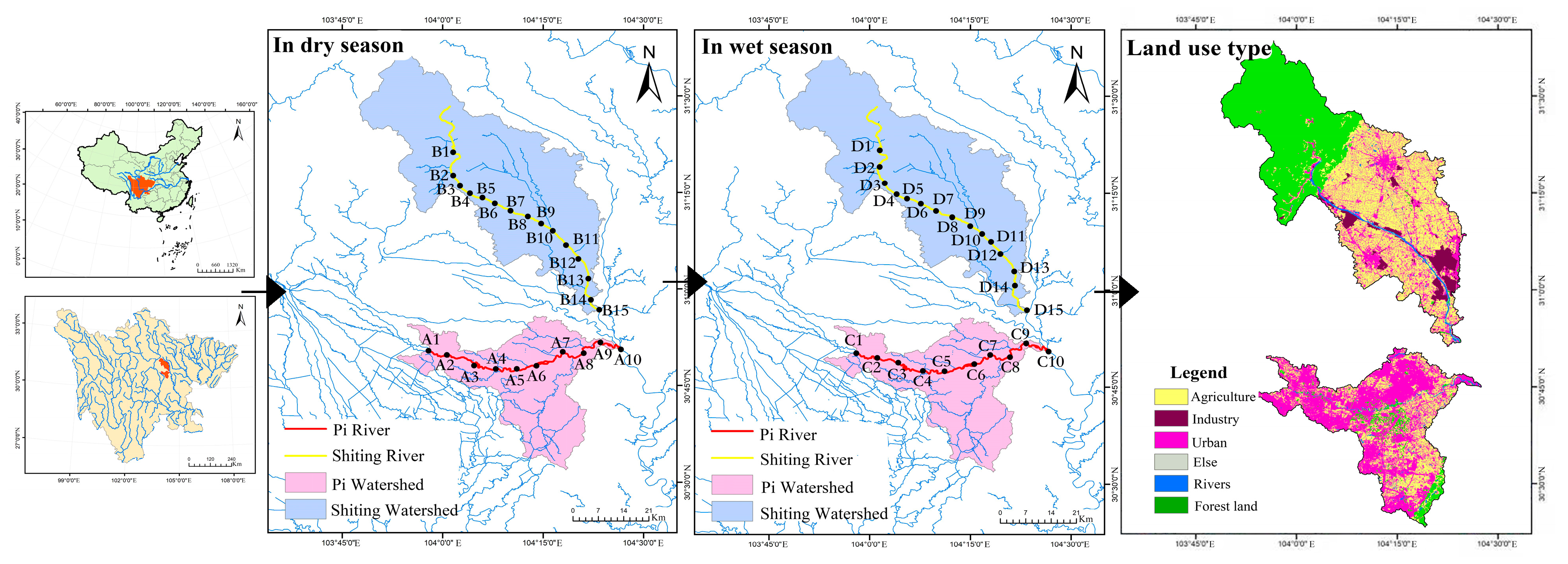

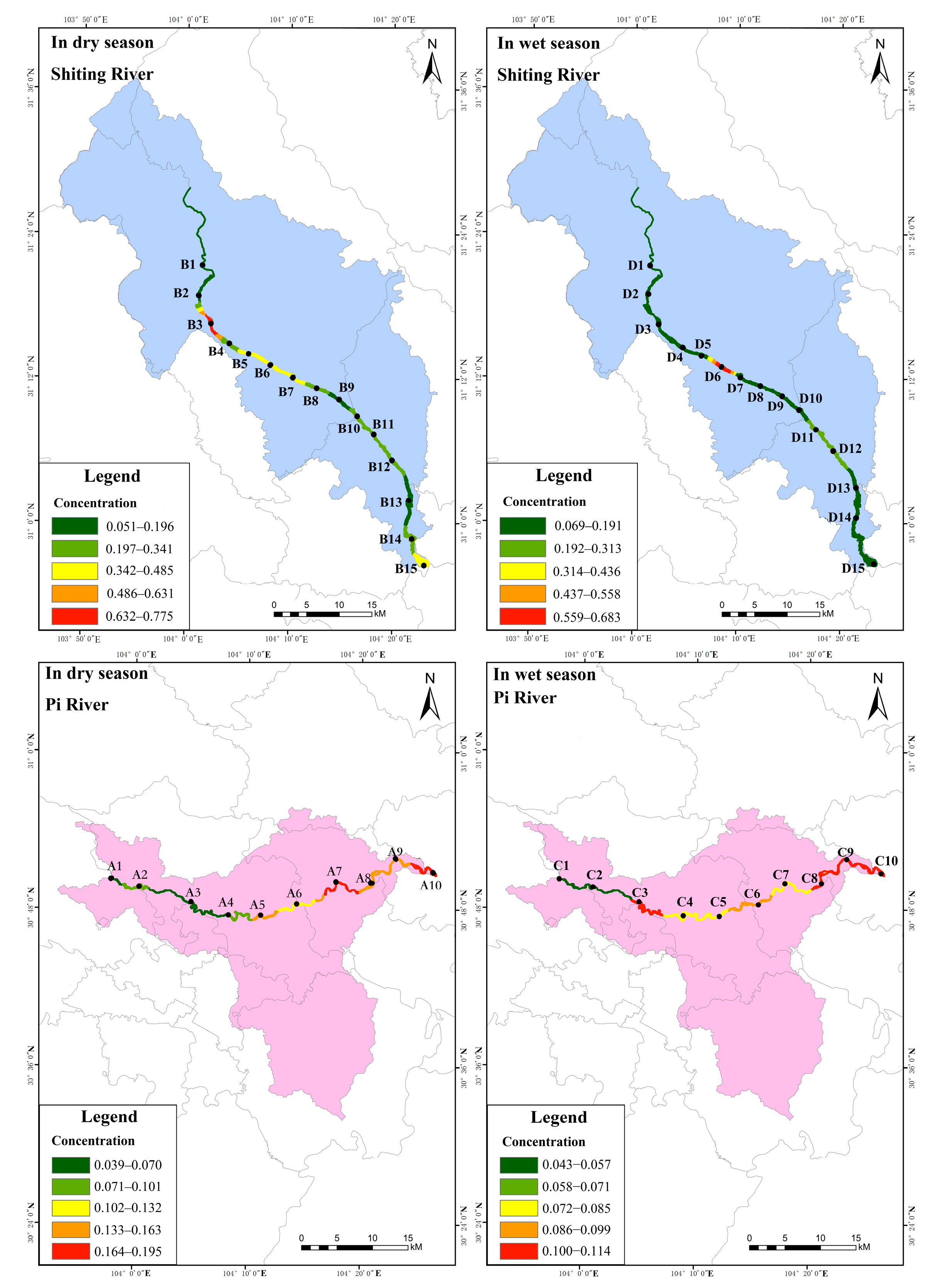
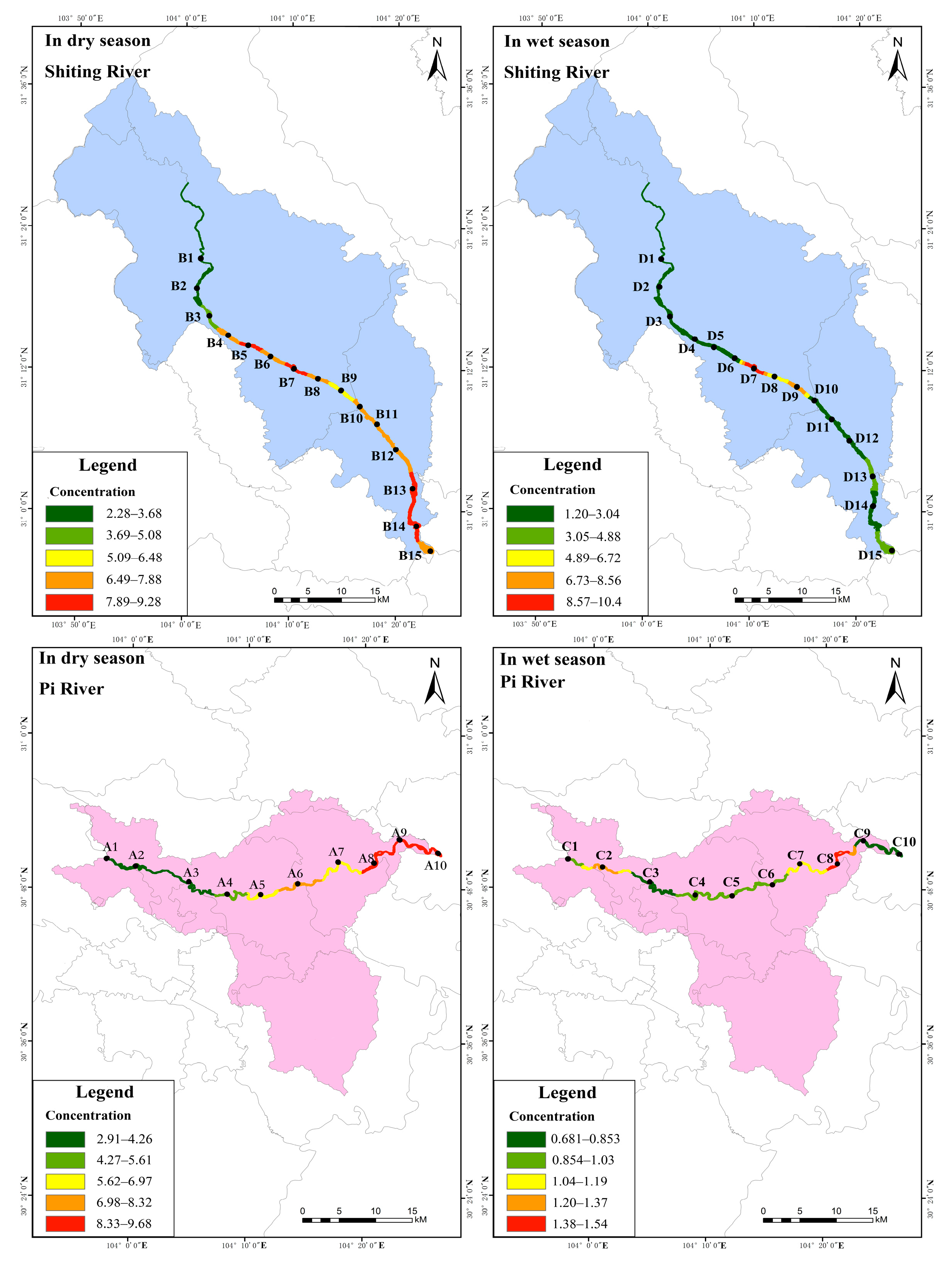


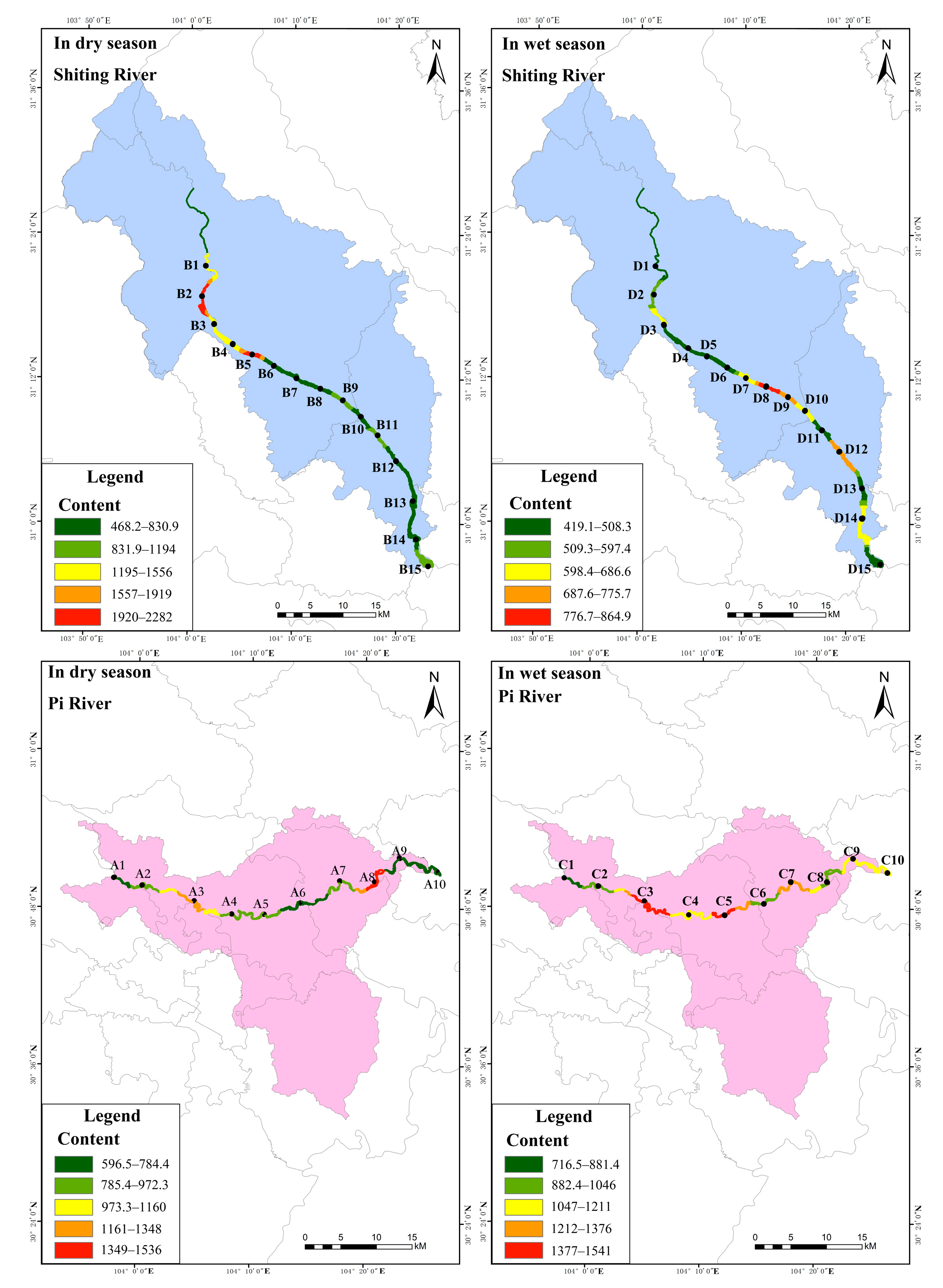
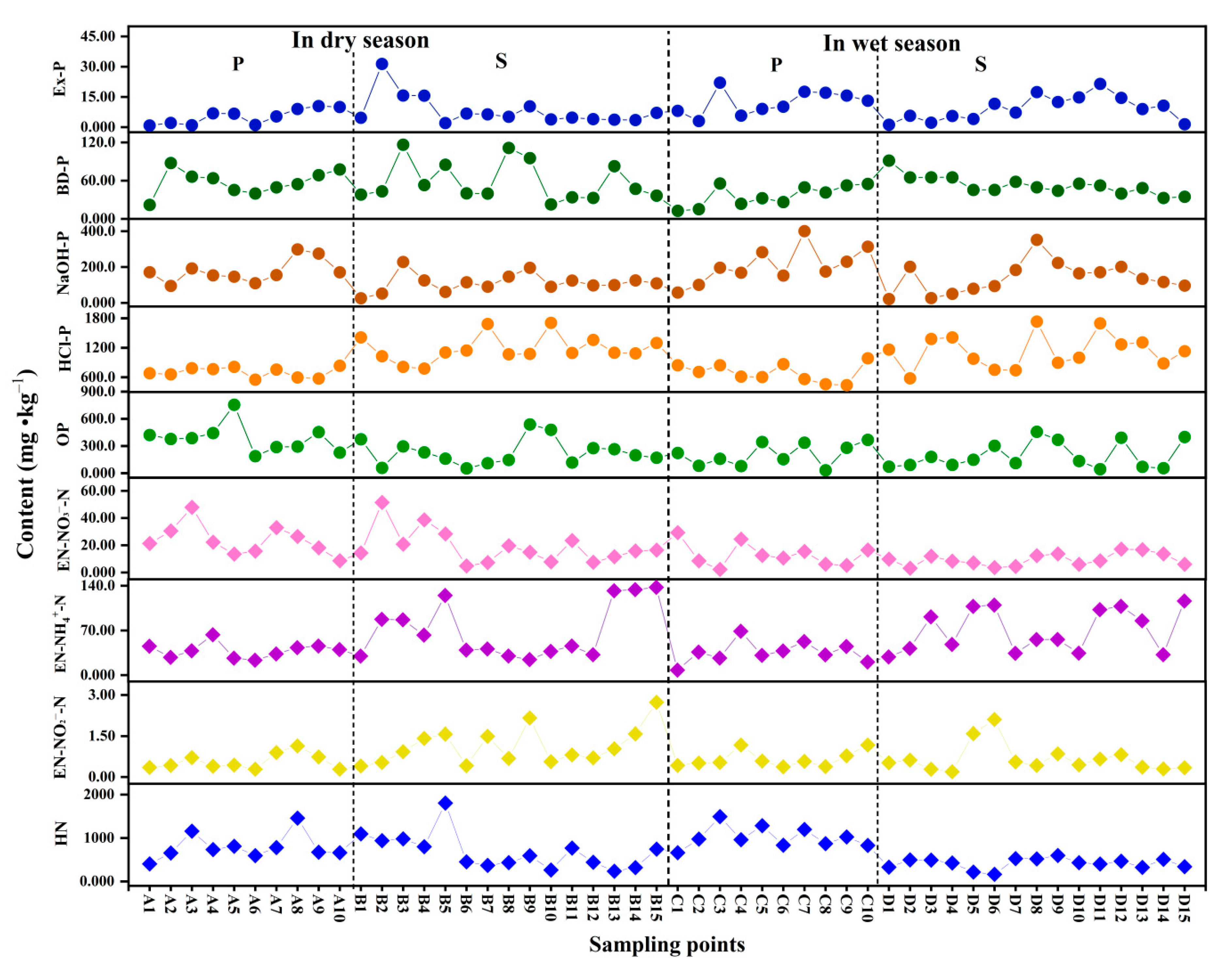
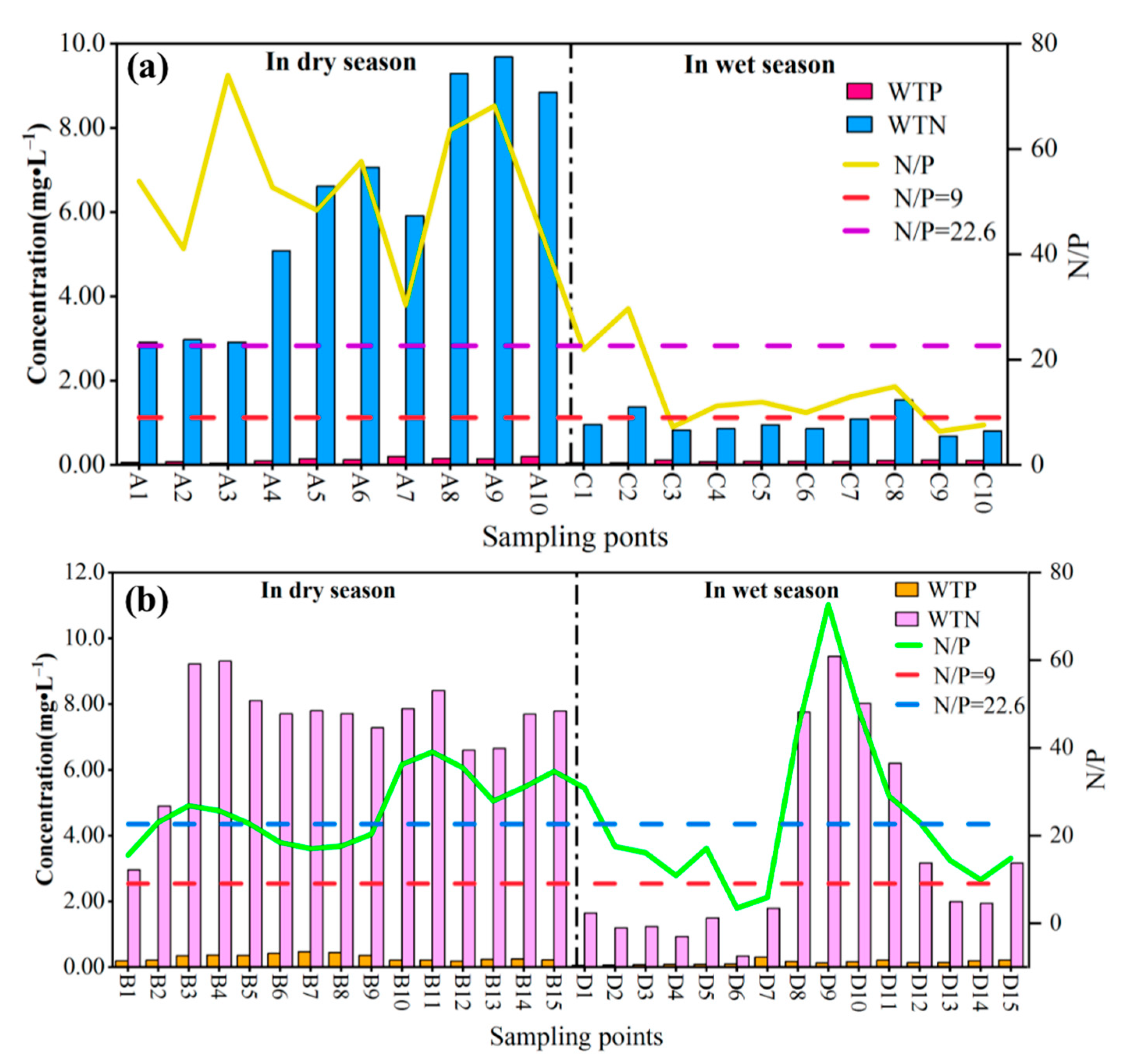

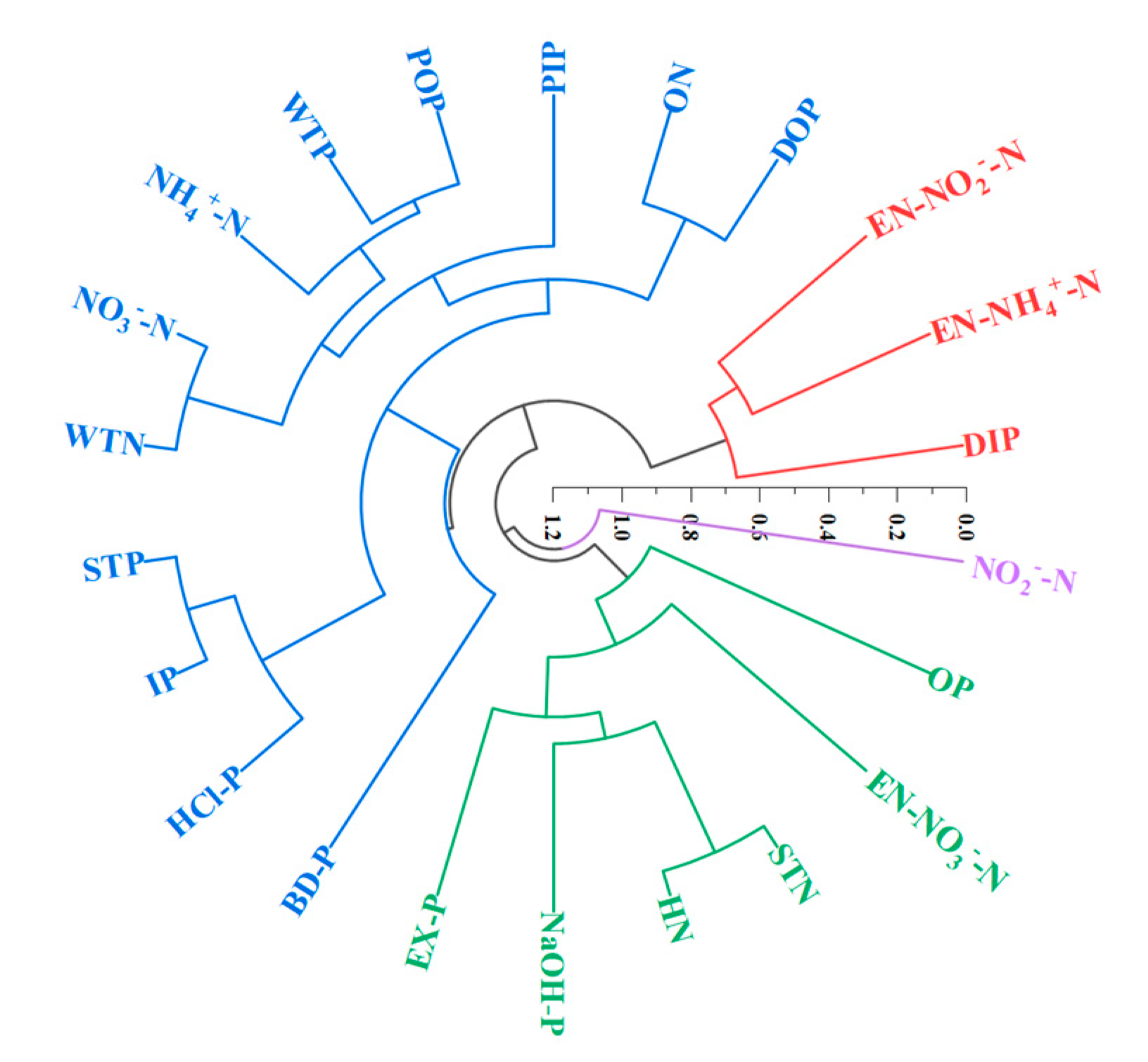

Publisher’s Note: MDPI stays neutral with regard to jurisdictional claims in published maps and institutional affiliations. |
© 2022 by the authors. Licensee MDPI, Basel, Switzerland. This article is an open access article distributed under the terms and conditions of the Creative Commons Attribution (CC BY) license (https://creativecommons.org/licenses/by/4.0/).
Share and Cite
Li, T.; Zhou, P.; Ding, Y.; Tang, Q.; Zhou, S.; Liu, Y. Distribution Characteristics and Source Analysis of Nitrogen and Phosphorus in Different Rivers in Two Water Period: A Case Study of Pi River and Shiting River in the Upper Reaches of Tuo River in China. Int. J. Environ. Res. Public Health 2022, 19, 12433. https://doi.org/10.3390/ijerph191912433
Li T, Zhou P, Ding Y, Tang Q, Zhou S, Liu Y. Distribution Characteristics and Source Analysis of Nitrogen and Phosphorus in Different Rivers in Two Water Period: A Case Study of Pi River and Shiting River in the Upper Reaches of Tuo River in China. International Journal of Environmental Research and Public Health. 2022; 19(19):12433. https://doi.org/10.3390/ijerph191912433
Chicago/Turabian StyleLi, Tongfei, Pingyan Zhou, Yunchang Ding, Qiding Tang, Shanshan Zhou, and Ying Liu. 2022. "Distribution Characteristics and Source Analysis of Nitrogen and Phosphorus in Different Rivers in Two Water Period: A Case Study of Pi River and Shiting River in the Upper Reaches of Tuo River in China" International Journal of Environmental Research and Public Health 19, no. 19: 12433. https://doi.org/10.3390/ijerph191912433
APA StyleLi, T., Zhou, P., Ding, Y., Tang, Q., Zhou, S., & Liu, Y. (2022). Distribution Characteristics and Source Analysis of Nitrogen and Phosphorus in Different Rivers in Two Water Period: A Case Study of Pi River and Shiting River in the Upper Reaches of Tuo River in China. International Journal of Environmental Research and Public Health, 19(19), 12433. https://doi.org/10.3390/ijerph191912433




